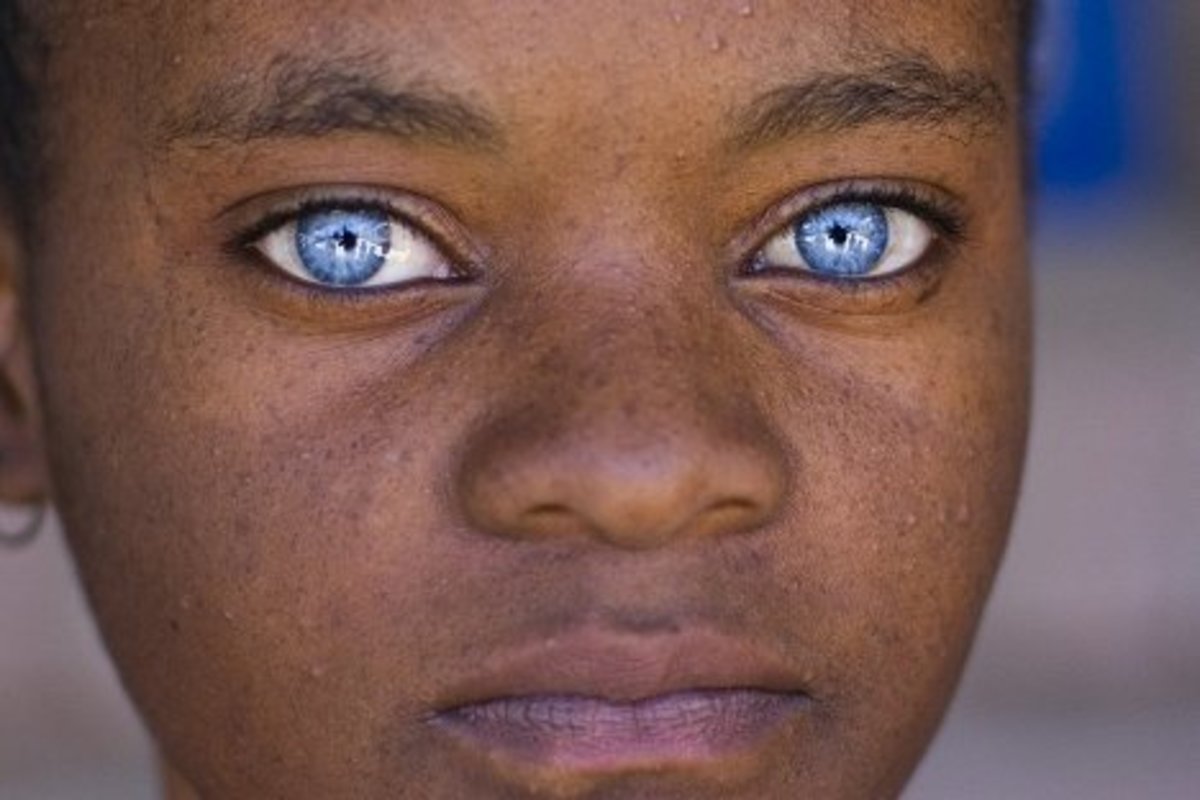Eye color is one of the most distinctive and intriguing features of human appearance, with shades that range from deep browns and hazels to rare hues of green and blue. The genetics behind eye color are complex and involve a combination of factors that influence not only the color itself but also variations within each shade. While it may seem like a simple trait, eye color is actually determined by a sophisticated interplay of genetics, biology, and physics. Factors such as melanin concentration, light scattering, and genetic interactions all contribute to the variety of eye colors seen in humans.
This article takes a look into what determines eye color, exploring the genetics behind the inheritance of eye color, the role of melanin in pigmentation, and how genetic variations contribute to the diversity of colors and patterns in human eyes.
The Basics of Eye Color and Melanin
The main factor that determines eye color is melanin, a pigment that also affects hair and skin color. Melanin is produced by cells called melanocytes within the iris, the colored part of the eye. The amount and distribution of melanin in the iris are the primary determinants of eye color. Eyes with high levels of melanin appear brown or black, while eyes with low levels of melanin can appear blue, green, or gray.
There are two types of melanin involved in eye color:
- Eumelanin: A dark pigment primarily responsible for brown and black colors.
- Pheomelanin: A lighter pigment that contributes to shades of yellow and light brown.
The combination and concentration of these melanin types within the iris cells influence the final color seen in the eye. Brown eyes, for instance, have a high concentration of eumelanin, giving them a rich, dark color. Blue eyes, on the other hand, have very low levels of melanin and depend more on the way light scatters within the eye to produce their characteristic color.
The Structure of the Iris and the Role of Light Scattering
The iris is made up of several layers, but the anterior stroma is the layer that primarily impacts eye color. The stroma consists of cells that can contain varying levels of melanin and collagen fibers. Eyes with lower melanin levels appear lighter in color due to the scattering of light by the collagen fibers in the stroma.
This scattering of light is called the Tyndall effect (similar to Rayleigh scattering, which makes the sky appear blue) and is responsible for blue eye color. When light enters the iris with minimal melanin to absorb it, the shorter blue wavelengths are scattered back outward, giving the eyes their blue appearance. This effect means that blue eyes do not actually contain blue pigment; instead, their color results from the way light interacts with the structures within the eye.
Genetic Basis of Eye Color: The Role of Multiple Genes
Historically, it was thought that eye color followed a simple Mendelian inheritance pattern where brown eye color was dominant over blue, and a single gene determined eye color. However, modern genetic research has shown that eye color is much more complex and is influenced by multiple genes, primarily located on chromosomes 15 and 19. The two main genes involved are OCA2 and HERC2 on chromosome 15, but other genes also contribute to variations in eye color.
OCA2 Gene
The OCA2 gene is one of the primary genes involved in determining eye color. It is responsible for producing the P protein, which helps control melanin production in the iris. Variations within the OCA2 gene can lead to different amounts of melanin, resulting in various shades from brown to blue. A specific variant in OCA2, particularly a single-nucleotide polymorphism (SNP), is strongly associated with lighter eye colors like blue.
HERC2 Gene
The HERC2 gene works closely with OCA2 to influence eye color. HERC2 contains a regulatory region that can either promote or inhibit the expression of OCA2, effectively controlling melanin production in the iris. For instance, a common variant in the HERC2 gene can reduce the activity of the OCA2 gene, resulting in lower melanin production and lighter eye colors.
Additional Genes and Complex Inheritance
In addition to OCA2 and HERC2, there are several other genes, such as TYR, SLC24A4, and TYRP1, that influence eye color by affecting melanin synthesis and distribution. Each gene adds small but important variations, contributing to the diversity of eye colors, such as gray, hazel, and green, which do not fit neatly into a simple brown or blue category.
This polygenic model of inheritance explains why eye color does not always follow predictable patterns. For example, two brown-eyed parents can have a blue-eyed child if both carry recessive alleles associated with lower melanin production. Similarly, the complex interplay of these genes can produce shades of green and hazel that do not strictly fit into the classic brown or blue spectrum.
Shades and Patterns in Eye Color: Brown, Blue, Green, Hazel, and Gray
Brown Eyes
Brown is the most common eye color globally and is dominant in many populations. The high concentration of melanin in the iris results in dark, rich colors that vary from light brown to nearly black. In regions such as Africa, Asia, and South America, brown eyes are nearly universal due to genetic selection for higher melanin production, which provides greater protection against UV radiation.
Blue Eyes
Blue eyes have very low levels of melanin and depend primarily on light scattering within the iris. This color is most common in individuals of European descent, particularly those from Northern Europe. Genetic mutations and variants in OCA2 and HERC2 are largely responsible for blue eye color, with the lower melanin levels giving rise to the characteristic light blue shade through the Tyndall effect.
Green Eyes
Green eyes are one of the rarest eye colors, resulting from a combination of low-to-moderate melanin levels and a mix of pheomelanin and eumelanin. The green hue occurs when the yellowish tones from pheomelanin combine with blue light scattering, producing shades ranging from olive to vibrant green. Green eyes are most commonly found among people of Celtic and Germanic ancestry.
Hazel Eyes
Hazel eyes are unique in that they often appear to shift color depending on lighting conditions and clothing. Hazel eyes contain a mixture of green, brown, and gold tones due to varying levels of melanin across the iris. This variation is caused by the uneven distribution of melanin in different parts of the iris, resulting in a combination of colors that gives hazel eyes their characteristic “flecked” appearance.
Gray Eyes
Gray eyes are another rare color, resulting from a very low melanin concentration combined with a high density of collagen fibers in the stroma that scatter light differently from blue eyes. The denser collagen fibers produce a grayish hue, which can sometimes appear blue or greenish under different lighting conditions. Gray eyes are most commonly found among people of Eastern European descent.
Eye Color Changes Over Time and Under Certain Conditions
Eye color can sometimes change over a person’s lifetime. Newborn babies, especially those of European descent, are often born with blue or gray eyes due to low melanin levels, which increase as they grow. By age 3, most children’s eye color stabilizes, as melanin production reaches its final level. However, changes in eye color can occasionally occur in adults due to factors like age, disease, or trauma.
Certain conditions, such as Horner’s syndrome or Fuchs heterochromic iridocyclitis, can also cause changes in eye color. Some medications, particularly those used to treat glaucoma, may lead to increased pigmentation in the iris, resulting in darker eye color over time. While such cases are rare, they illustrate the role that external and medical factors can play in altering eye color.
The Science of Heterochromia and Other Unique Eye Patterns
Heterochromia is a condition in which an individual has two different colored eyes or variations in color within a single iris. Heterochromia can be congenital (present at birth) or acquired due to injury or illness. There are several types:
- Complete Heterochromia: One eye is entirely different in color from the other (e.g., one brown eye and one blue eye).
- Sectoral (or Partial) Heterochromia: A segment of one iris is a different color from the rest of the eye, creating a “split” effect.
- Central Heterochromia: The inner ring of the iris is a different color from the outer ring, often creating a multicolored appearance around the pupil.
Heterochromia results from differences in melanin distribution within the irises and can be genetic or caused by trauma, disease, or medication. In most cases, heterochromia does not affect vision, though it is sometimes associated with certain genetic conditions like Waardenburg syndrome or Horner’s syndrome.
Evolutionary Perspectives on Eye Color Diversity
The variation in eye color among humans is believed to be influenced by evolutionary factors. Darker eye colors, which are prevalent in regions with high UV radiation (such as Africa, Asia, and the Middle East), offer greater protection against sunlight and are therefore more common in these regions. In contrast, lighter eye colors, such as blue and green, are more common in areas with lower UV exposure, such as Northern Europe, and may have arisen as a result of genetic drift or sexual selection.
One theory suggests that lighter eye colors became more common in Northern Europe due to reduced sunlight exposure and the need for more vitamin D synthesis, as light-colored eyes allow more light to penetrate. Another theory is based on sexual selection, suggesting that unique eye colors like blue and green became more desirable and were passed down through generations.
Eye Color and Health Implications
Although eye color itself does not directly impact health, certain studies suggest that melanin levels in the eye may correlate with specific health risks. For example:
- Individuals with lighter eyes (blue or green) may be more sensitive to bright light and more prone to UV-related eye damage. They may also have a slightly higher risk of developing age-related macular degeneration.
- Individuals with darker eyes (brown) may have a lower risk of UV damage but are more susceptible to cataracts.
These differences are minor and generally do not significantly affect health but may be a consideration in protecting vision with appropriate eyewear in bright conditions.
Conclusion: A Complex Interplay of Genetics and Biology
Eye color is determined by a complex interaction of genetic and biological factors, with melanin concentration, genetic variants, and light-scattering effects all contributing to the diversity of human eye colors. While the genes OCA2 and HERC2 play a significant role in determining eye color, the involvement of multiple other genes and genetic factors adds layers of complexity that make eye color inheritance difficult to predict with certainty.
From the rich browns and blacks to the rare greens and grays, eye color reflects a combination of evolution, genetics, and the intricate structure of the human iris. Understanding eye color not only sheds light on the uniqueness of human genetics but also highlights the fascinating ways in which tiny molecular changes contribute to visible diversity, making each person’s appearance truly one-of-a-kind.




